Global Orthodontic Brackets Market Size and Trends
The global orthodontic brackets market is estimated to be valued at USD 2.26 Bn in 2025 and is expected to reach USD 3.78 Bn by 2032, exhibiting a compound annual growth rate (CAGR) of 7.4% from 2025 to 2032.
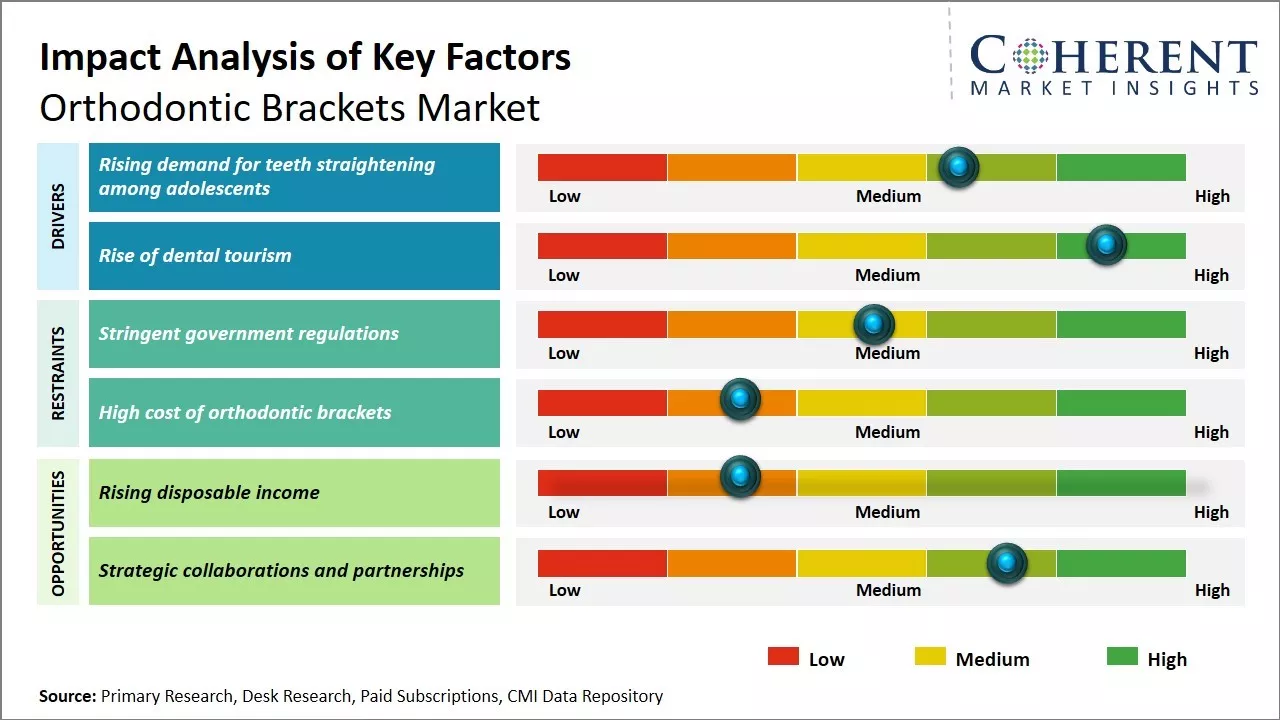
Discover market dynamics shaping the industry: Download Free Sample
The global orthodontic brackets market is expected to witness positive growth over the forecast period. Technological advancements in orthodontic bracket designs for enhanced efficacy and user comfort are expected to drive the market growth.
Growing consumer acceptance of orthodontic treatment options to address dental misalignments and jaw problems is further expected to augment demand of orthodontic brackets. Increasing availability of customized clear aligners and invisible orthodontics for both adults and teenagers will support the market expansion through the forecast period. However, availability of alternative treatment options and high cost of orthodontic treatments are expected to restrain the revenue growth of the orthodontic brackets market to a certain extent in the near future.
Rising demand for teeth straightening among adolescents
The use of orthodontic brackets is growing significantly among the adolescent population across major countries such as U.S., U.K., Germany, India, and Japan. With rising awareness about the importance of oral health and aesthetics, more and more parents are willing to invest in teeth straightening procedures for their children at a young age. Teenagers have become much more conscious about their physical appearance lately. Crooked or irregularly aligned teeth can affect their confidence and self-esteem during the important years of schooling and socialization. This has emerged as a major factor prompting parents to opt for braces for kids in their early and mid-teenage phases.
Braces are widely regarded as a necessity rather than mere luxury by several families. With improving economic conditions as well, people are ready to spend on orthodontic treatment to enhance children's physical features. Advanced straightening technologies using new materials like ceramics and lingual brackets have addressed previous concerns around the aesthetics of metal wires. This has further encouraged adolescent patients to undertake corrective procedures without compromising on natural looks. Peer pressure and social media influences seem to be playing a pivotal role in creating this increased need for an aesthetically appealing smile.
Market Concentration and Competitive Landscape
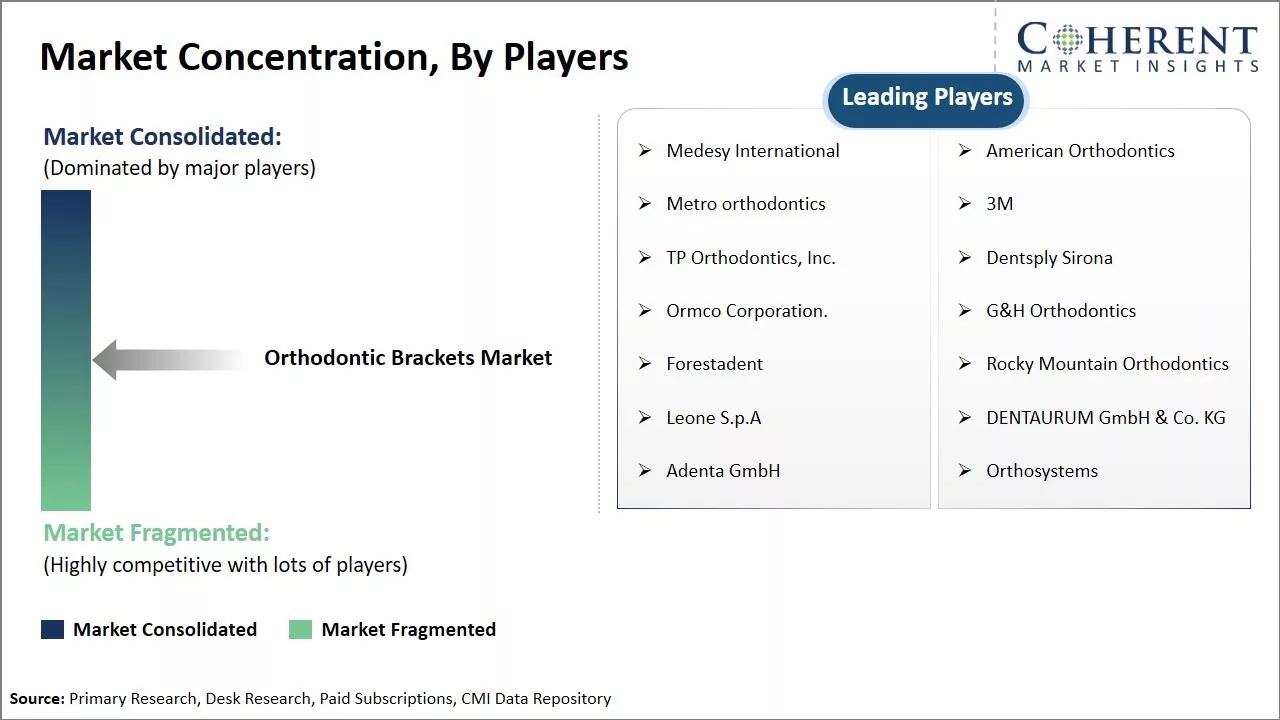
Get actionable strategies to beat competition: Download Free Sample
Rise of dental tourismDental tourism has led to the rise in the global demand for orthodontic brackets and aligners. Significant cost savings that are associated with medical tourism in several developing Asian countries, Mexico, and Eastern Europe have made dental procedures more affordable for international patients. Advanced diagnostics and treatment modalities comparable to developed markets combined with relatively lower costs are attracting patients in large numbers from the U.S., Western Europe, and other highly-priced regions. Countries like India, Thailand, Hungary, and Poland are emerging as popular destinations for people in U.S., U.K. and other countries who are seeking quality dental services at substantially lower costs. This price arbitrage is driving medical tourists to opt for long term corrective treatments overseas as well. The flourishing dental tourism business has created new revenue pools for global orthodontic supplies industry including brackets manufacturers. It is enabling greater affordability and accessibility of standard orthodontic solutions worldwide.
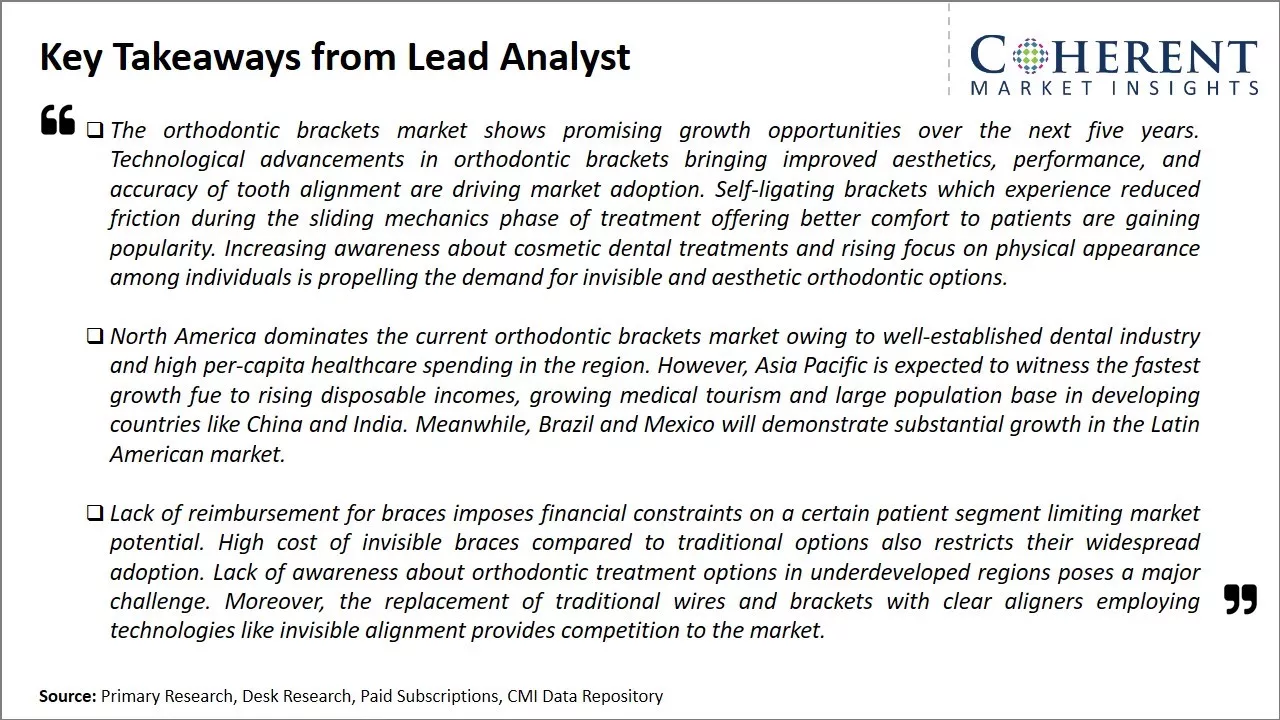
To learn more about this report, Download Free Sample
Market Challenges – Stringent government regulations
The global orthodontic brackets market faces several challenges. Manufacturers in this market must navigate significant research and development (R&D) costs to design new innovative products that improve treatment outcomes. Market players find it difficult to expand globally due to differing international regulations. Established companies also have to compete against low-cost generics that capture price-sensitive consumers. Marketing orthodontic treatments also poses a challenge as many people are either not open or cannot afford aesthetic dental procedures.
Market Opportunities – Rising disposable income
There are several opportunities available in this market. Growing emphasis on physical appearance and beauty is driving more individuals towards straightening their teeth. Rising incomes mean more patients can afford orthodontic treatments. Advanced customized brackets that are tailored for specific patients could further increase demand. Numerous opportunities also exist in growing markets like Asia Pacific, Latin America, and Eastern Europe with expanding middle-income populations.
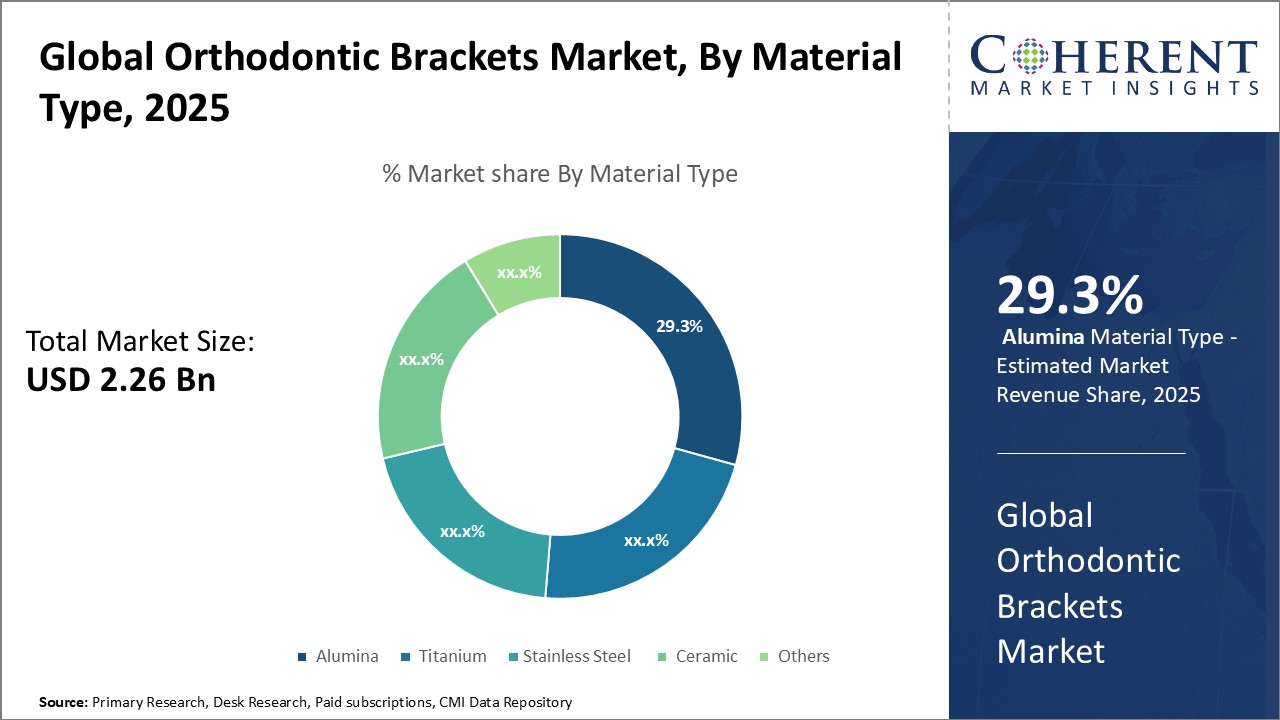
Discover high revenue pocket segments and roadmap to it: Download Free Sample
Insights, By Material Type: Superior biocompatibility drives alumina growth
The material type segment includes stainless steel, titanium, alumina, ceramic, and others. By material type, alumina is expected to have 29.3% of the market share in 2025. Alumina brackets are made from polycrystalline aluminum oxide, which provides excellent corrosion resistance and durable aesthetic appearance as compared to other materials. Its crystalline structure makes alumina brackets exceptionally strong and long-lasting on teeth. Alumina's outstanding biocompatibility stems from its chemical inertness and lack of cytotoxicity. Unlike metal brackets that are made from stainless steel or titanium, alumina releases no metal ions into the oral cavity that could cause toxicity, allergic reactions, or tissue inflammation over time. This ensures patient comfort throughout orthodontic treatment and faster healing of gum tissues. Alumina's pH neutrality and non-porous nature also prevents plaque buildup and eliminates the scope for decalcification or decay under brackets.
Insights, By Ligation System, Patient comfort drives preference for self-ligation system
The ligation system includes conventional ligation and self-ligation. By ligation system, self-ligation segment is estimated to have 57.3% of the market share in 2025. Self-ligating brackets eliminate the need for supplementary elastic/wire modules to close the bracket slot, since the self-ligating clip performs this function inherently as part of the bracket design. Doing away with separate ligatures provides numerous clinical benefits. Firstly, it drastically reduces opportunities for wounds or injuries to delicate oral tissues and lips from poking or cutting by exposed ends of elastic threads or tied ligature wire. Self-ligation thus promises greater comfort during eating, speaking, and oral hygiene measures. Secondly, in conventional ligation replacing or re-tying elastic modules disrupts the aligned archwire position, whereas self-ligating clips engage or disengage the archwire non-invasively. This ensures continuous gentle force delivery to teeth with minimal chances of losing correction between office visits. It also speeds up routine check-ups and wire changes.
Insights, By End User: Patient volumes drive dental clinics' growth
The end user segment includes hospitals, dental clinics, and others. In terms of end user, dental clinics are anticipated to have 42.2% of the market share in 2025. While hospitals provide orthodontic services, outpatient dental clinics remain the primary point of care for majority of orthodontic cases. Dental clinics are well equipped to manage a wide spectrum of malocclusions from minor alignments to complex jaw surgeries. Their orthodontists and staff are highly specialized in orthodontics alone. Large clinics also offer cost benefits due to economies of scale. Streamlined workflows ensure quick throughput of patients. Moreover, the familiar neighborhood environment of dental clinics is less intimidating for children and adults alike. People are comfortable building long-term relationships with their trusted clinic orthodontist, aiding follow-ups, compliance, and post-treatment retention. Retainer checks over lifetime are more conveniently sought at local clinics.
Regional Insights
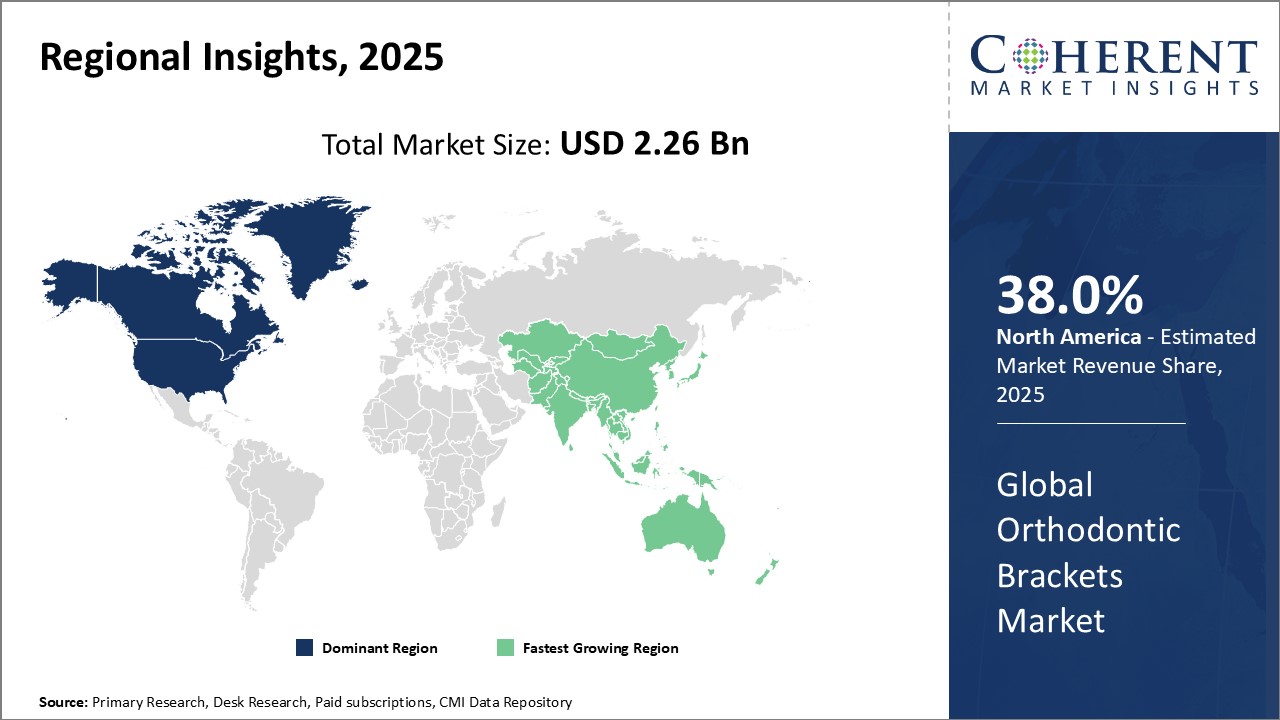
Need a Different Region or Segment? Download Free Sample
North America has historically been the dominant region in the global orthodontic brackets market and is anticipated to account for 38.0% of the market share in 2025. This is due to factors like high awareness levels regarding orthodontic treatments and dental aesthetics amongst consumers in countries like the U.S. North America is also home to several world-leading dental equipment manufacturers and suppliers. Orthodontic brackets from companies that are based in the region cater to both the domestic demand as well as overseas exports.
Asia Pacific has emerged as the fastest growing regional market in recent times. Countries like China, India, and Japan have witnessed rapid economic development which has boosted discretionary expenditure capabilities of their large and growing middle class populations. As affordability of dental treatments rise, more people are seeking orthodontic procedures like braces for straightening crooked or misaligned teeth. Domestic manufacturing capabilities are also enhancing in the region, thereby allowing for better availability of orthodontic brackets at competitive prices. Medical tourism has contributed to braces becoming a highly popular dental procedure performed on foreign patients visiting countries like Thailand and South Korea.
In Europe, countries such as Germany, France, and the U.K. have established dental markets with high rates of orthodontic treatment adoption especially among younger age groups. Local manufacturing along with imports from major global suppliers ensures abundant supply of various orthodontic bracket options in European markets. Aesthetic attributes like appearance and color matching with natural tooth shades are particularly important considerations for European consumers, driving demand for advanced bracket designs. Meanwhile, Latin America has shown increased uptake of clear aligners and less visible dental correction options owing to conscious image appeal.
Market Report Scope
Global Orthodontic Brackets Market Report Coverage
| Report Coverage | Details | ||
|---|---|---|---|
| Base Year: | 2024 | Market Size in 2025: | USD 2.26 Bn |
| Historical Data for: | 2020 To 2024 | Forecast Period: | 2025 To 2032 |
| Forecast Period 2025 to 2032 CAGR: | 7.6% | 2032 Value Projection: | USD 3.78 Bn |
| Geographies covered: |
|
||
| Segments covered: |
|
||
| Companies covered: |
Medesy International, American Orthodontics, Metro orthodontics, 3M, TP Orthodontics, Inc., Dentsply Sirona, Ormco Corporation. , G&H Orthodontics, Forestadent, Rocky Mountain Orthodontics, Leone S.p.A, DENTAURUM GmbH & Co. KG, Adenta GmbH, Orthosystems |
||
| Growth Drivers: |
|
||
| Restraints & Challenges: |
|
||
Uncover macros and micros vetted on 75+ parameters: Get instant access to report
Global Orthodontic Brackets Industry News
- In September 2023, Ormco Corporation, a medical device company, launched Ormco Digital Bonding (OBD). Doctors can improve their daily routine and get personalized bracket positioning by combining Damon Ultima brackets and Spark Approver Software.
- In August 2023, LightForce Orthodontics, the makers of the world's first fully individualized 3D printed braces system, announced a USD 80 million Series D funding round led by Ally Bridge Group, a global healthcare investment management firm. LightForce Orthodontics will use the funding to promote its aim of empowering orthodontists to provide personalized treatment with custom 3D printed brackets by expanding manufacturing with a new facility, extending the use of artificial intelligence (AI) in its workflows and investing in education.
- In April 2023, SprintRay Inc., a digital dentistry industry leader, announced a partnership with Braces On Demand, an online platform for in-office printing of orthodontic fixed appliances. The partnership will provide automated, end-to-end 3D printing solutions for orthodontic practices, thus improving patient treatment times and productivity.
- In July 2020, the American Association of Orthodontists supported the specialty by investing in patient care innovations through its innovation and transformation fund. The fund, which can be used to develop new products and services for orthodontists and patients through creating, partnering, or investing, made its second investment of USD 50,000 in KLOwen Custom Braces System, an in-office, same-day custom bracket solution that improves doctor efficiency.
*Definition: Orthodontic brackets are small devices that are bonded to the teeth during orthodontic treatment to correct issues with dental alignment and bite. These brackets act as handles to hold the orthodontic wires that move the teeth. Brackets can be made from a variety of materials, including stainless steel, titanium, alumina, ceramic, and plastic.
Market Segmentation
- Material Type Insights (Revenue, USD Bn, 2020 - 2032)
- Stainless Steel
- Titanium
- Alumina
- Ceramic
- Others
- Age Group Insights (Revenue, USD Bn, 2020 - 2032)
- Adults
- Children
- Indication Insights (Revenue, USD Bn, 2020 - 2032)
- Allergic Disorders
- Gastrointestinal Disorders
- Central Nervous System Disorders
- Dermatological Disorders
- Others
- Ligation System Insights (Revenue, USD Bn, 2020 - 2032)
- Conventional Ligation
- Self Ligation
- End User Insights (Revenue, USD Bn, 2020 - 2032)
- Hospitals
- Dental Clinics
- Others
- Regional Insights (Revenue, USD Bn, 2020 - 2032)
- North America
- U.S.
- Canada
- Latin America
- Brazil
- Argentina
- Mexico
- Rest of Latin America
- Europe
- Germany
- U.K.
- Spain
- France
- Italy
- Russia
- Rest of Europe
- Asia Pacific
- China
- India
- Japan
- Australia
- South Korea
- ASEAN
- Rest of Asia Pacific
- Middle East
- GCC Countries
- Israel
- Rest of Middle East
- Africa
- South Africa
- North Africa
- Central Africa
- North America
- Key Players Insights
- Medesy International
- American Orthodontics
- Metro orthodontics
- 3M
- TP Orthodontics, Inc.
- Dentsply Sirona
- Ormco Corporation.
- G&H Orthodontics
- Forestadent
- Rocky Mountain Orthodontics
- Leone S.p.A
- DENTAURUM GmbH & Co. KG
- Adenta GmbH
- Orthosystems
Share
Share
About Author
Manisha Vibhute is a consultant with over 5 years of experience in market research and consulting. With a strong understanding of market dynamics, Manisha assists clients in developing effective market access strategies. She helps medical device companies navigate pricing, reimbursement, and regulatory pathways to ensure successful product launches.
Missing comfort of reading report in your local language? Find your preferred language :
Transform your Strategy with Exclusive Trending Reports :
Frequently Asked Questions
EXISTING CLIENTELE
Joining thousands of companies around the world committed to making the Excellent Business Solutions.
View All Our Clients
